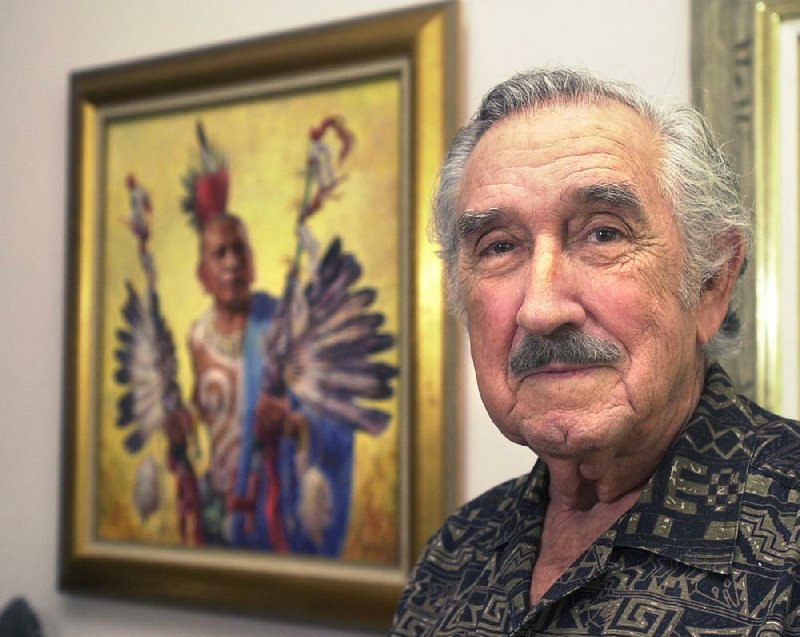“Art is a struggle to give meaning to experience. It is a lie which helps us picture the truth.”-Charles Banks Wilson
Truth emerges time and time again in the revealing portraits of American Indian life by Charles Banks Wilson.
Wilson “blazed a path unique to American art,” said Anne Morand, curator of art for the National Cowboy & Western Heritage Museum in Oklahoma City. “[He] follows in the footsteps of people like Thomas Eakins and Diego Vasquez, who painted to recognize the character, the inner importance, the strength it took to survive what they have gone through.”
Wilson, born Aug. 6, 1918, in Springdale, died May 2 in Rogers.
For many, even in the art community, he may not have been familiar. “Artists can sort of get out of the mainstream of knowledge,” said Morand, former chief operating officer of the C.M. Russell Museum in Great Falls, Mont., and an expert and author on Western art. “But anyone with any love or care about American art in general has an understanding that raw talent can take you only so far.”
Wilson didn’t consider himself a regional painter or a Western artist.
“His view was a world view,” Morand said. “There’s not really a place where you can identify him with an art movement. He was so far above most artists of his generation; he had an amazing understanding and command of any art medium. He is hardto categorize. Charles was a great objective realist, a great historical painter and one of pure aesthetics as well.”
Wilson’s muse was a restless one. Beginning in 1938 he visited Indian tribal lands and traveled the Santa Fe Trail in 1960 with fellow artist Thomas Hart Benton. He was an illustrator of more than two dozen books including Treasure Island. His work often showed that restless nature, revisiting themes over several works. White Hats, for example, began as a charcoal drawing in 1952, became a lithograph in 1978 (several were hand-colored) and in 1985 turned into a full-color painting. The work suggests an experimentation with cubism. Some of his other portraits hint at artists such as Manet and Rousseau.
“He was very humble; if I had that much talent, I’d have such a big head no one would be able to stand it,” Morand said. “Charles didn’t wait for things to come to him, literally or figuratively. He sought out things that people maybe hadn’t done before while following in the footsteps of great regionalists before him.”
Wilson’s greatest achievement is a body of work known as The Purebloods, a collection of drawings and paintings that began in 1938 and is part of the collection of Gilcrease Museum in Tulsa. The word, coined by Wilson, was used to describe people of a single tribal ancestry.
“It embodies everything-his incredible aesthetic, the beauty of the works regardless of subject. It is historic and ethnographic,” said Morand. “Charles gives us a look at native Americans, what their life was like, during a time of the last of the traditional lifestyles of the 20th Century.”
The Purebloods is an important historical record as vital as the 19th-Century paintings of George Caitlin and the late 19th-Century/early 20th-Century photographs of Edward Curtis. Many of Wilson’s Pureblood drawings are in his book Search for the Native American Purebloods.
“I drew the individual-rather than the anthropology-to save a likeness,” Wilson said in 2003. He drew what will never again be visible, he said. “The face is a record of a life.”
Movie cowboy Gene Autry tried to buy the collection, but Wilson wouldn’t sell because he told the American Indians who served as his subjects that the works would go to a museum. He kept his word.
As a child, Wilson and his family moved from Arkansas to Miami, Okla., near the land inhabited by several displaced American Indian tribes. It was there he saw American humorist Will Rogers perform; young Wilson sketched the Oklahoma actor and commentator and did his first painting of Rogers in 1935. A year later he was studying at the Art Institute of Chicago.
Wilson often used the word “storyteller” to describe what he did.
“Every one of those pictures exist because I have a story to tell,” Wilson told the Democrat-Gazette in 2003. “When I see the paintings, what comes to my mind is when I did it and what the circumstances were; it’s almost as though I wasn’t the artist but the observer.”
Morand said it is that quality of observation that set Wilson apart.
“He was willing to be patient, to watch, until he saw what he thought was the most important thing,” she said. “That’s why his portraits are so strong. His paintings of powwows, he’s observing what is important about people and how you include that in a view of that person. He didn’t pretty ’em up and they were beautiful because of that. It is a real beauty because of a life that’s been lived.”
Perspective, Pages 75 on 05/26/2013

